If you’re looking for a spectacular plant to add to your collection but the “regular” Swiss cheese plant (Monstera deliciosa) doesn’t quite cut it, I’ve got a treat for you today. Meet Monstera Variegata, the variegated Monstera! It’s got those same familiar jungle vibes, plus beautiful mottled foliage that really catch the eye.
Keep reading for everything you need to know about variegated Monstera care and how to grow this spectacular plant indoors.
| Common name(s) | Variegated Monstera, Monstera Variegata |
| Scientific name | Monstera deliciosa |
| Family | Araceae |
| Height and spread | Up to 10 feet high and 5 feet wide indoors |
| Light | Bright indirect |
| Soil type | Aroid soil |
| Water | Keep lightly moist |
Disclosure: If you shop from my article or make a purchase through one of my links, I may receive commissions on some of the products I recommend.

About variegated Monstera
Natural habitat
Variegated Monsteras don’t exist in the wild. It’s not impossible for one to pop up, since the coloring is a random mutation, but the plant would probably quickly die off due to being less efficient at photosynthesizing than its green counterparts. In cultivation, though, variegated Monsteras survive and can be used to produce new plants by means of propagation.
Monstera deliciosa, the species’ wild form, is naturally found in Central American rainforests. It grows as a liana (a long-stemmed woody vine) using taller trees as supports, climbing upwards in order to reach more light.
What is variegation?
Variegated Monstera plants are characterized by their mottled foliage, a unique coloring caused by the lack of green pigment in some of the plant cells. Depending on the exact cultivar or variety, the variegation can differ in color (yellow, cream, light green, pure white) and pattern (speckled, blocky, splotchy).
There are two main types of variegation found in Monsteras: marbled and sectoral.
Marbled variegation features patches of light and dark distributed fairly evenly across the leaf.
Sectoral variegation features large patches of white on the leaf. A leaf can have both marbled and sectoral variegation at the same time.
Related: Marble Queen Pothos Care: Ultimate Growing Guide for Devil’s Ivy Plant (Epipremnum Aureum)
In principle, a variegated Monstera is the same plant as its non-variegated counterpart (the Monstera deliciosa most people know and love). It just carries a genetic anomaly, naturally occurring or otherwise, that causes it to produce less chlorophyll in certain parts of its leaves. Chlorophyll is what makes a leaf green and allows it to photosynthesize. If there is less or none of it present, that (part of the) leaf will be lighter or fully white.
Description
Monstera deliciosa is a hemiepiphyte. A hemiepiphyte is a non-parasitic vining plant that lives part of its life as an epiphyte. That means Monstera deliciosa starts out by growing in the soil, then seeks a host (a tall jungle tree) and climbs it like a ladder in search of sunlight, using aerial roots to latch on.
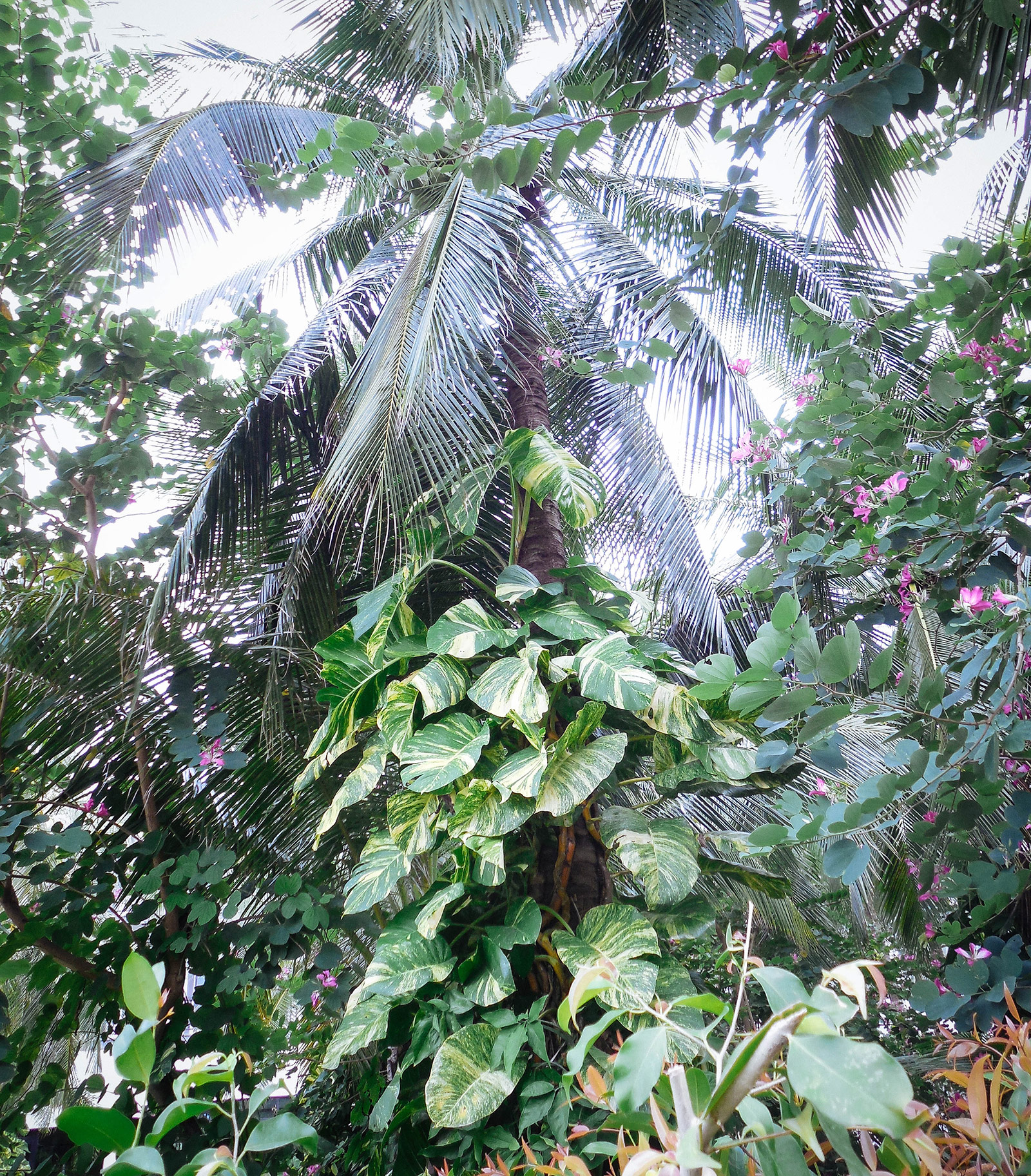
This climbing behavior is typical of other vining aroids you might have as houseplants, including silver Monsteras, mini Monsteras (which are actually not Monsteras at all), and arrowhead plants.
The Monstera deliciosa plant produces large, glossy, heart-shaped leaves that can feature extensive splits and holes (known as fenestrations). Fenestration typically begins once the plant is about 3 feet tall, and these holes have a function: They help the large leaves withstand heavy rainfall in their native rainforest habitat by letting the elements pass through.
When grown outdoors, Monstera deliciosa can produce a sweet edible fruit that tastes like a cross of pineapple, mango, passionfruit, and strawberries. In fact, this is where the plant gets it name: Monstera means strange (referring to the fenestrations in its leaves) and deliciosa means delicious (referring to its fruit). In variegated cultivars, this fruit is actually mottled in color instead of uniform light green!
Although it doesn’t quite reach the same height and leaf size in the home that it will outdoors—maxing out around 10 feet rather than 65 feet or more—the Swiss cheese plant still falls firmly into the XL plant category.
Although the variegated version doesn’t grow quite as quickly (due to its reduced chlorophyll), be sure you can accommodate its size if you really want to enjoy its full potential.
Why are variegated Monsteras so expensive?
If you’re in any type of houseplant-centered Facebook group, Instagram account, or other places where folks discuss the indoor gardening hobby, you’ll have noticed that houseplant aficionados go wild for variegated Monsteras! What’s the hype? After all, this plant isn’t cheap by any means.
Although the price tag has dropped a good bit over the past few years, in the United States, you can still expect to pay at least:
- $30 to $60 (depending on your area) for an unrooted stem-only cutting, which can be a hassle to root
- $50 to $100 (depending on your area) for a single-leaved cutting
- Up to $300 for a plant with a few leaves
- Up to $500 for a well-established plant
And those are the cheapest prices online; local greenhouses and garden centers may sell their variegated Monsteras for even more. Price also depends on the variety and type of variegation. (We’ll discuss a few different ones below.)
Did you know? One of the reasons fewer variegated Monsteras are available is because they can’t be grown from seed. I mean, they can, but the variegation won’t be passed on. You’ll just get a normal green Monstera deliciosa. Consider that before you jump on cheap “Monstera variegata seeds” on Etsy! Scammers are happy to profit off houseplant enthusiasts trying to get in on a trend.
If you’re wondering why people would shell out this kind of money, you’ll have to consider that it’s not just about how pretty the plant is. The houseplant hobby is absolutely partly about showing off one’s collection. Who has the rarest and coolest plants?!
When a new variety pops up and fetches high prices, it creates a kind of perfect storm. A bubble forms. Everyone wants in so they can show off, as well as sell cuttings of their own to make a profit.
With a plant like the variegated Monstera, its slower growth rate (consider the fact that Costa Farms has announced it’s not able to produce Monstera ‘Thai Constellation’ on a mass scale) plus its popularity on social media make it quite expensive. The circle self-perpetuates, because a pricey plant gives a certain air of status and exclusivity.
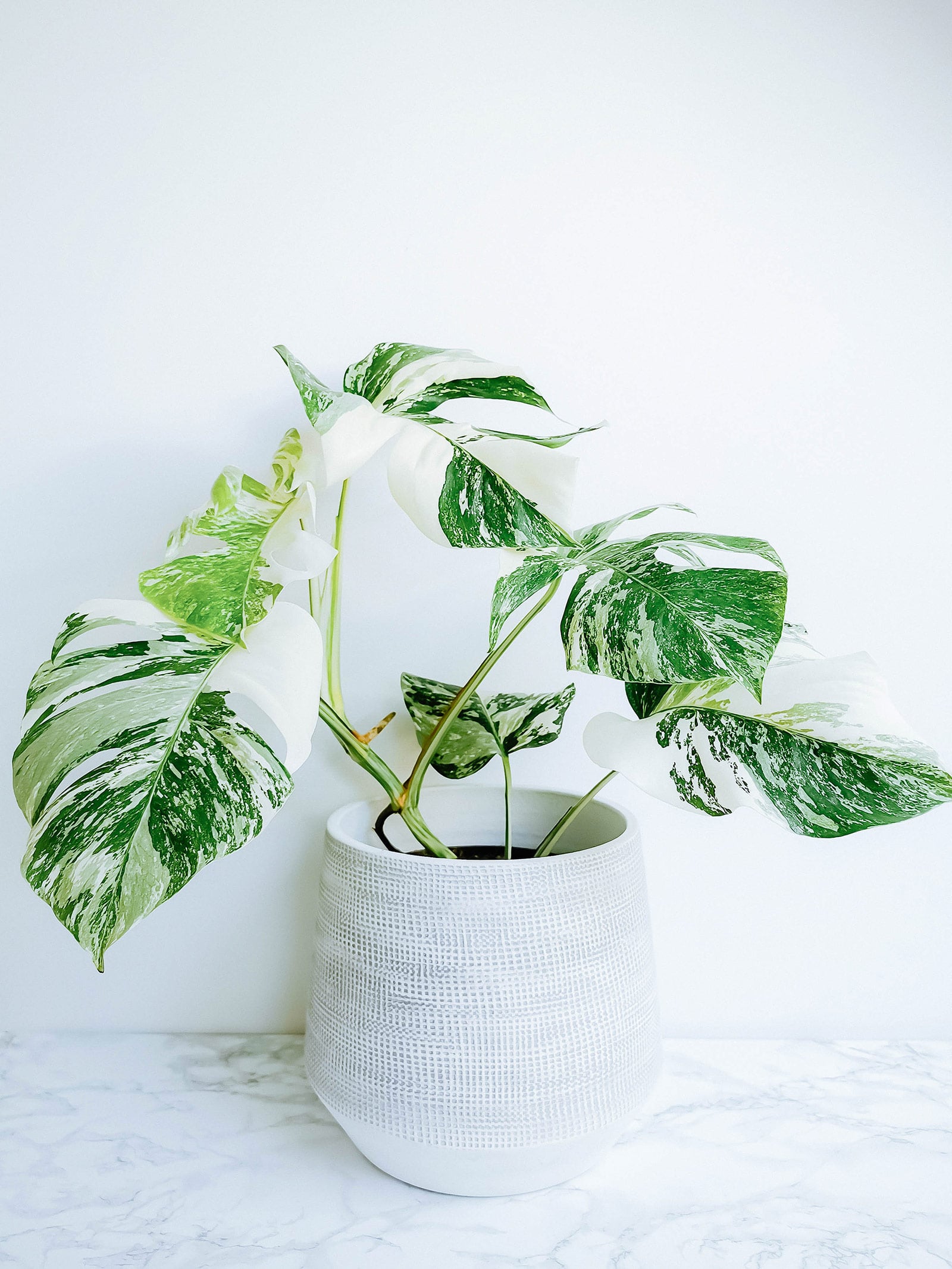
Variegated Monstera varieties
There is a bit of discussion when it comes to which are the different variegated Monstera varieties. Their appearance changes with the environment and many cultivars aren’t patented, so it can be difficult to figure out what you’ve got on your hands. It doesn’t help that sellers can and will slap pretty much any label on a plant.
With that in mind, the following varieties are widely accepted:
- Monstera ‘Variegata’: You could consider this the original variegated Monstera. It refers to genetic mutations in plants grown from seed, which are rare. The variegation is random, and can therefore be any color or pattern.
- Monstera ‘Albo Borsigiana’: Also called Monstera Albo, this one’s very popular and sports white variegation in large blotches and splotches. It can produce coveted half-moon and even full moon* (completely white) foliage. Tends to stay a bit smaller than, for example, ‘Thai Constellation’.
- Monstera ‘Thai Constellation’: Also one of the most popular varieties, this one is supposedly more stable in its variegation. It features tiny cream specks that are indeed a little reminiscent of a starry constellation. Apparently it was genetically engineered by a lab in Thailand, which managed to activate just the right genetic markers to get the plant to produce less chlorophyll in some places.
- Monstera ‘Mint Variegata’: The name says it all, this one’s characterized by its minty green and white variegation. A new kid on the block and still difficult to find, it’s quite the looker. Sometimes you’ll find this plant referred to as simply “mint Monstera.”
- Monstera ‘Aurea’: The word Aurea roughly means “golden,” which of course refers to this variety’s yellowish variegation. This variegation can consist of splotches, speckles or both. Splotched specimens usually aren’t very strongly variegated.
* Unfortunately, although they look great in photos, most houseplant experts recommend removing full moon leaves. They can’t photosynthesize and they drain energy from the plant, often dying off on their own after a while.
Where to buy variegated Monstera plants:
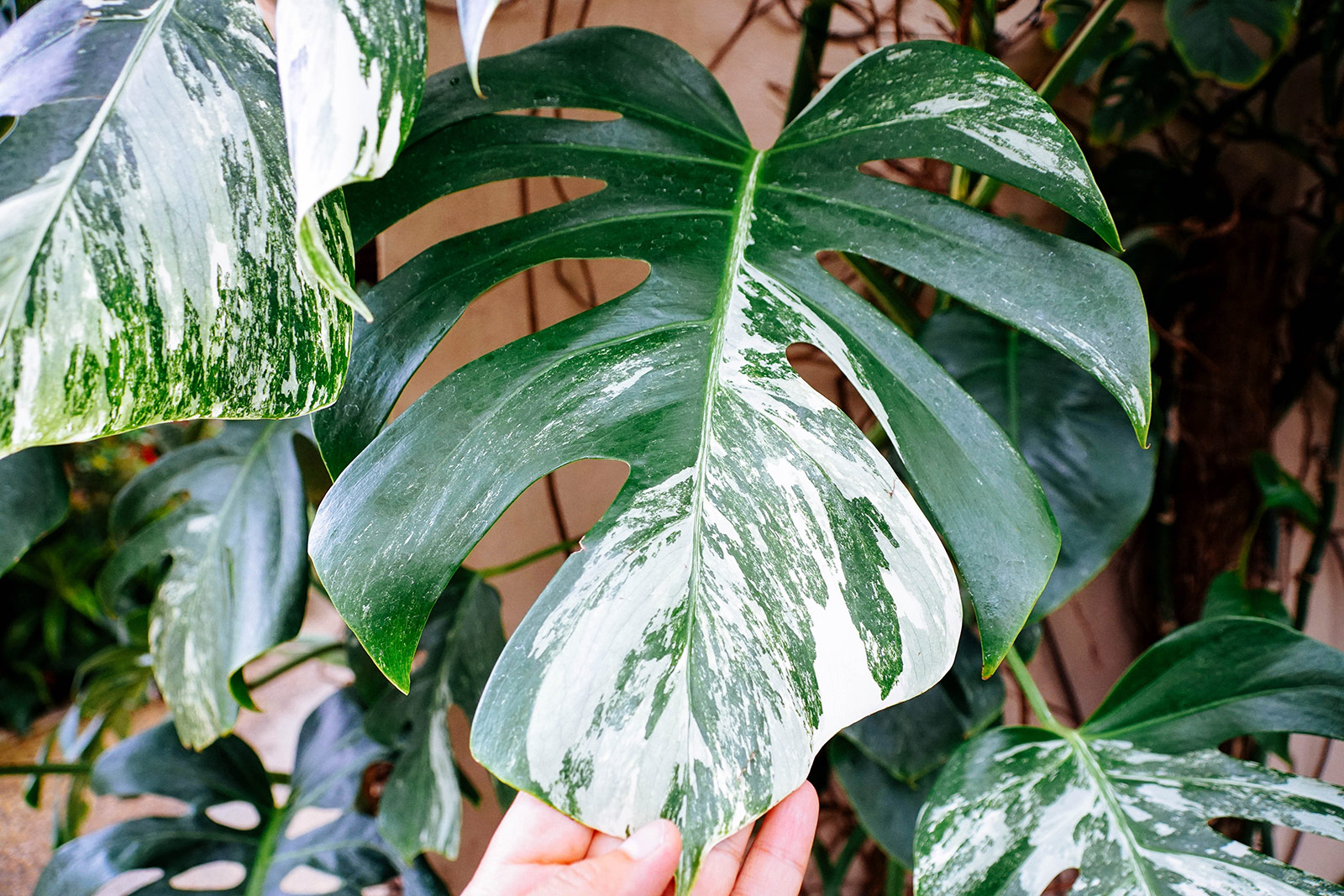
Caring for variegated Monstera
Light and temperature
Finding the right balance for your variegated Monstera houseplant is important to keep it looking its best. Variegated plants can begin to put out foliage with more green and less mottling if they’re kept too dark, which kind of defeats the purpose of having one! On the other hand, heavily variegated leaves do burn more easily, so they should be protected from harsh direct sun.
In practice, this means that a spot next to most windows will work fine for your variegated Monstera. If the window is very large and gets a lot of afternoon sun, then you might want to consider placing the plant a few feet away from it or using a sheer curtain to offer some protection.
If you have a light meter, 200- to 500-foot candles should work well. Don’t forget to acclimate the plant over the course of a few weeks if you’re moving it to a much brighter location.
As for temperature, the most important thing to remember is that this is a tropical plant, and a relatively fragile one at that. It doesn’t like the cold and will probably stop growing entirely if you let things drop below 59°F.
I expose my normal Monstera deliciosa to chilly conditions all the time, but for a more expensive plant like Monstera Albo or any of the variegated types, your best bet is to just keep it at room temperature. If you feel comfortable in your home, then your variegated Swiss cheese plant will as well. Higher temps shouldn’t be a problem.
Did you know? If your variegated Monstera has begun to put out green foliage due to a lack of light, it may begin to produce properly mottled leaves again once you move it to a brighter spot in your home. If this isn’t the case, it’s possible you’ll have to cut the plant back to the last properly variegated leaf, as described in the section on pruning.
Water and humidity
I unfortunately can’t tell you how often you should be watering your variegated Monstera. Watering frequency depends completely on factors like soil, season, light levels, and more. In fact, watering on a set schedule often does more harm than good! It’s a much better idea to learn how to gauge when your plant needs a drink.
The easiest ways to figure out whether your Monstera Variegata is thirsty are to stick your finger in the soil mix or to lift the pot to feel how much it weighs (although the latter may not be the most practical method if your plant is already huge). If the soil feels humid or the pot feels heavy, it isn’t time to water yet. Wait until the top of the soil has dried out or the pot’s weight has gone down.
As for humidity, this again is one of those cases where I personally wouldn’t be too concerned about the whole thing if this was a normal Monstera deliciosa—but given the variegated Monstera’s price tag and slightly more fragile nature, it’s something to keep a close eye on. (I like this digital humidity meter for my own house.)
If your house consistently drops under 50 percent humidity, you may want to consider running a humidifier to keep your variegated Monstera happy.
Soil and planting
What kind of soil will your variegated Monstera do best in? Vining aroids like this one appreciate a loose soil type, something that allows their roots to breathe. There are many different mixtures you can whip up, containing all sorts of soil (or soilless) media. The right one for your houseplants depends on your own preferences and watering habits, but something basic should work for almost everyone.
A simple starter option that your Swiss cheese plant should do fine in is:
- 50 percent high-quality houseplant potting soil
- 25 percent perlite
- 25 percent orchid bark
- Optional: Replace some of the perlite and bark with sphagnum moss if you tend to underwater.
As for the type of planter, that doesn’t matter much as long as it has a drainage hole. Some space for a sturdy moss pole or plant totem would also be handy, as your variegated Monstera will very much appreciate being able to climb.
These types of plants tend to become too top-heavy over time to keep themselves upright if you don’t give them some support, which may result in them falling over and breaking. Adding some kind of pole keeps your houseplant balanced and will promote quicker growth.
Recommended products for variegated Monstera plant care:
- Good Earth Organics Premium Potting Soil
- FoxFarm Ocean Forest Potting Soil
- Perfect Plants Organic Perlite
- Better-Gro Orchid Bark
- Better-Gro Orchid Moss
- Totem Monkey Extendable Coir Moss Poles
Fertilizing
Monstera Variegata is slower growing than its regular cousin, which means it also needs less fertilizer. Still, don’t let it go without! You can use a diluted liquid aroid fertilizer every month or so during the growing season, applying it during waterings.
Don’t use fertilizer to try and give your variegated Monstera a boost if it isn’t growing much or looking its best. Also refrain from feeding the plant during the inactive winter months—it won’t benefit from the extra nutrients, they’ll just end up burning the roots.
Recommended fertilizers for variegated Monsteras:
- Houseplant Resource Center Monstera Plant Food
- Espoma Concentrated Organic Indoor Plant Food
- The Grow Co. Organic Indoor Plant Food
Pruning
It’s generally not necessary to do any pruning on a houseplant like this one, aside from the occasional removal of dead leaves. There are two exceptions.
One is what I’ve briefly touched upon: It’s recommended to remove full moon (completely white) leaves from your plant. They just sap its energy and eventually die off on their own anyway.
Another reason to prune would be if your variegated Monstera is beginning to revert. In some cultivars, like ‘Thai Constellation’, this doesn’t happen, since the variegation is part of its genetic make-up. In others, like ‘Albo Borsigiana’, it’s a possibility.
Sometimes it’s a result of low light conditions, other times it’s just bad luck! Although you can place your plant in a brighter location, provide great care and hope for the best (which usually works if it reverted due to lack of light), many houseplant enthusiasts prefer to prune.
You can cut your Monstera Variegata back to the last variegated leaf. It will re-sprout from another growth point, hopefully with proper variegation this time. You can also re-grow the top of the plant (the green part you removed) as a normal Monstera deliciosa by following the instructions in the section on propagation below.
Dividing or repotting
Because Monstera houseplants rarely produce offshoots, repotting is usually the way to go, though you could opt to chop up your variegated Swiss cheese plant if it gets too large for your liking. Cuttings can be sold or used to grow more plants, if you wish.
A happy and healthy Monstera Variegata will likely need an upgrade every one to two years. If yours has outgrown its current planter and you’d like to repot, try a new container that’s an inch or two larger than the previous one. Give the plant fresh soil and try to be careful with the roots.
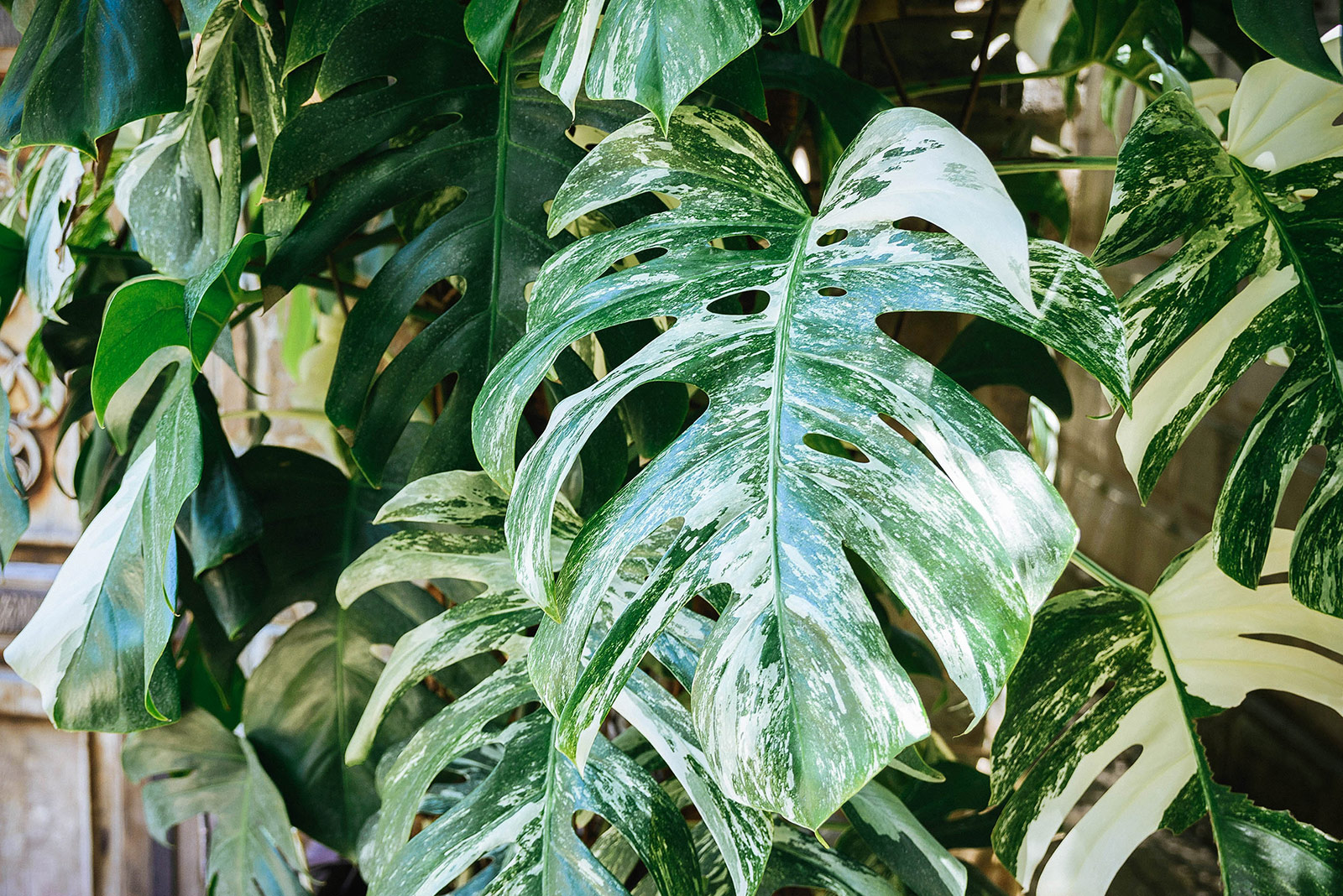
Propagating variegated Monstera
Because an established variegated Monstera plant is still so expensive to buy, most indoor gardeners opt for unrooted cuttings. These are much cheaper, but of course, you do need to know how to get them rooted.
As discussed earlier, you’ll find different types of cuttings for sale. The cheapest is a stem-only cutting (also known as a wet stick), which is also the most challenging and the slowest to root since it doesn’t have any leaves.
Cuttings with one or two leaves, attached to a piece of stem with at least one node, are quicker and less prone to rot. However, they’re also on the pricey side.
So how do you make sure your variegated Monstera cutting doesn’t wither and rot? Everyone has their favorite propagation methods, but a few of the most common (and promising) options include:
- Propagating variegated Monstera in water: A bit difficult with a wet stick, but it can be done with a leafed cutting. Leave the cutting in a glass with filtered water in a bright (but not sunny) location until the roots are a few inches long, then transfer to normal aroid plant soil. Not the most popular option, since the switch to soil can be hard on a plant.
- Propagating variegated Monstera in sphagnum moss: Works with all types of cuttings. You can also add some perlite. Keep the cutting well-lit and the moss moist but not wet, transferring to soil once a good root system has been established.
- Propagating variegated Monstera in perlite or LECA: Works best with leafed cuttings. Fill a cup without a drainage hole with your preferred medium. Insert the cutting in such a way that it doesn’t fall over but also isn’t too deep, and fill one-third of the way with water. The perlite or LECA should wick just the right amount of moisture to the plant.
When propagating in moss, perlite, or LECA, it can be handy to use a humidity dome like this one (or just a plastic bag) to keep the humidity around your variegated Monstera cutting high. You can remove this aid once the plant seems well-rooted. Some rooting hormone also always comes in handy! (I’ve used this rooting hormone with great success.)
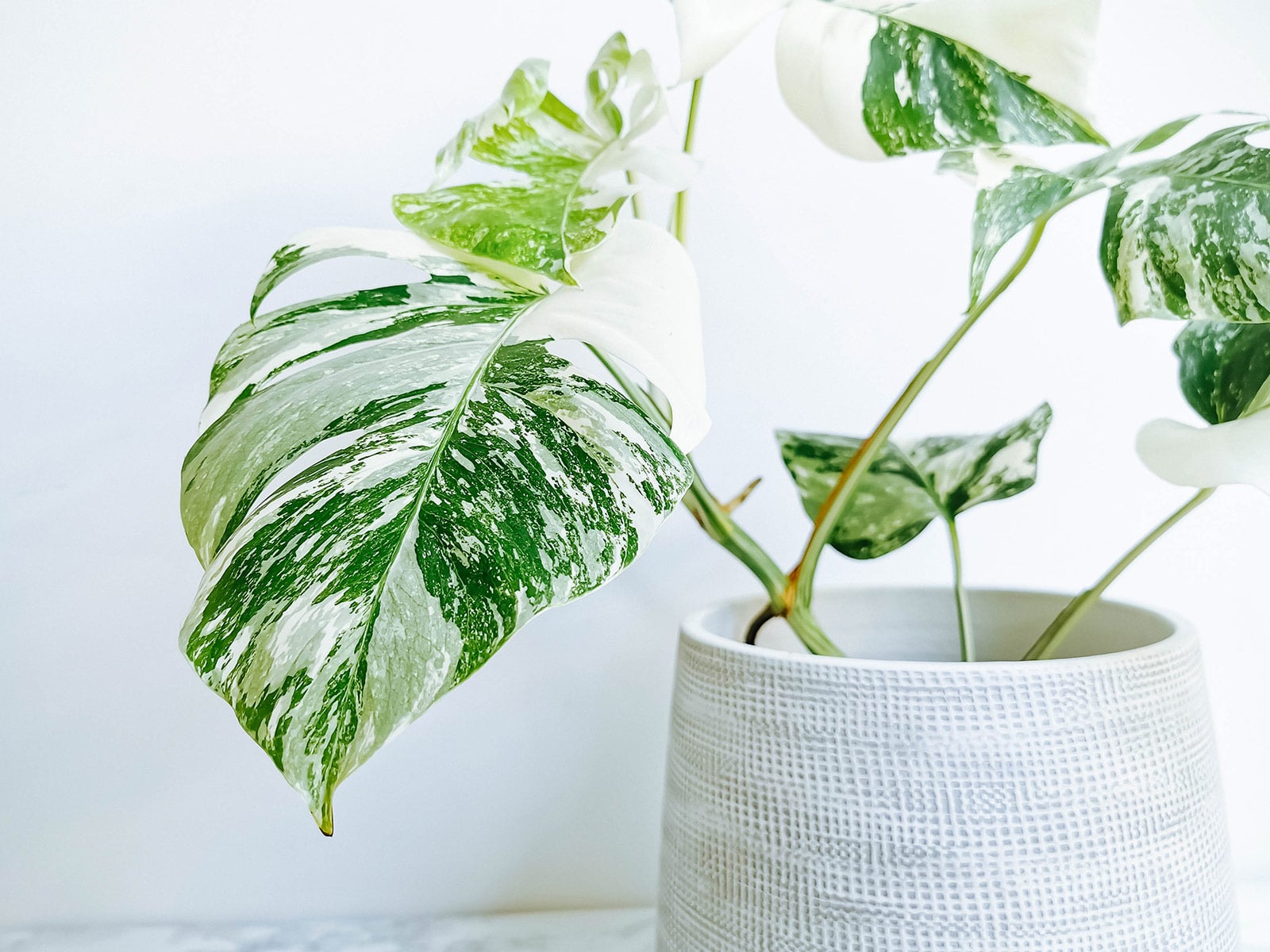
Common questions about variegated Monstera care
How do I make my Monstera more variegated?
You can promote more variegation in a Monstera Variegata by placing your plant in a spot with more sunlight. The darker it is in the room, the more green leaves are produced. The brighter it is (near a south-facing window, for instance), the more variegation the plant will put out in its leaves.
Why are my Monstera leaves not splitting?
If you just purchased a new Monstera deliciosa plant and you’re wondering why it doesn’t have its characteristic splits and holes (known as fenestrations), this usually comes down to two things: the age of the plant and the available sunlight.
A Monstera won’t begin fenestrating until it’s about 3 years old (roughly 3 feet tall). If it isn’t receiving enough light in your home, that’s another reason it might not fenestrate. Also, it’s natural for some leaves on a plant to split, while others remain whole.
As long as you’re giving your Monstera plenty of bright indirect light, it’ll continue to grow new leaves that start splitting as the plant matures.
Is a Monstera the same as a split-leaf Philodendron?
No, Monsteras and Philodendrons are two different plants. Though they may look similar (especially when they’re young), Monsteras and Philodendrons belong to different genera and species, despite being part of the same family (Araceae).
Is a variegated Monstera toxic to cats and dogs?
Although it’s not outright toxic and very unlikely to kill anyone, all parts of Monstera deliciosa and its variegated counterparts contain calcium oxalate crystals. These cause irritation when they touch the skin or mucous membranes. If your furry friend takes a bite, offer plenty of water and keep an eye out for swelling.
View the Web Story on variegated Monstera plant care.















